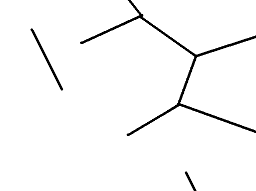Quote:Original post by Bob Janova
'Ends' of your graph seem to be represented by vertices with two edges (i.e. the point of a triangle), so that may be where to start.
Not necessarilly. Sometimes an ending looks like this:
..---- |..-----..----/
Quote:Original post by Bob Janova
I don't quite understand what the overall problem is. It may well be possible to go directly from your 'red blobs' to the region bounding lines, but without knowing quite what the regions represent or how they're supposed to relate to each other it's difficult to think along those lines.
The regions are supposed to represent two kinds of areas:
- narow passages ("tunnels")
- wide open areas
My goal is to decompose terrain description, given as grids and (possibly) other static objects to such areas, so I could improve my AI, from hierarchical pathfinding, to better environment awarness of units.
The endings of the yellow graph represent places where a tunnel is supposedly ending and an open area is starting. The splits of the graph represent places where one tunnel is meeting with another(s).
I can connect points of yellow graph to nearest "walls", to make those divisions, but I have to choose those points wisely, to make as many divisions as necessary, but not more.
 Is to be reduced to:
Is to be reduced to:
 I can see two possible ways of handling this.
1. With some statistical/algebraic mambo-jumbo, distinguish the points that are near the "splits" from those that are far from them (on the "edges" of the final graph). Such points (and all other in the nearest vicinity) will be assumed to belong to a single vertex of the final graph. With such "coloring", we could distinguish "edge" parts from "vertex" parts and proceed with BFS to make up connections between the parts.
It's the "mambo-jumbo" stage that is an enigma to me.
2. Something involving "real" graph algorithm, like (this is from the top of my head) Strongly-Connected-Components and the family. But I don't know much about that...
How can I proceeed with this?
Any ideas appreciated.
~def.
----
(*) Since The Grand Goal, which is terrain analysis, might be possible to acomplish with some other means.
I can see two possible ways of handling this.
1. With some statistical/algebraic mambo-jumbo, distinguish the points that are near the "splits" from those that are far from them (on the "edges" of the final graph). Such points (and all other in the nearest vicinity) will be assumed to belong to a single vertex of the final graph. With such "coloring", we could distinguish "edge" parts from "vertex" parts and proceed with BFS to make up connections between the parts.
It's the "mambo-jumbo" stage that is an enigma to me.
2. Something involving "real" graph algorithm, like (this is from the top of my head) Strongly-Connected-Components and the family. But I don't know much about that...
How can I proceeed with this?
Any ideas appreciated.
~def.
----
(*) Since The Grand Goal, which is terrain analysis, might be possible to acomplish with some other means.







